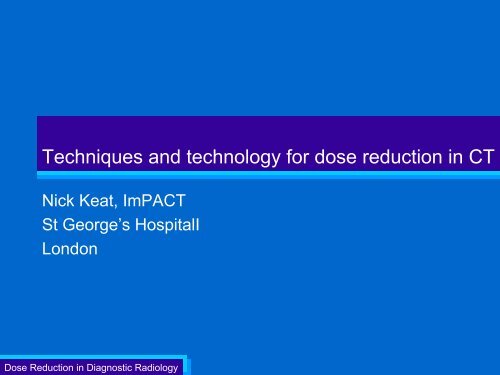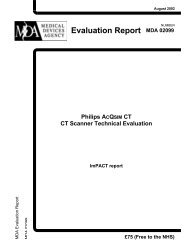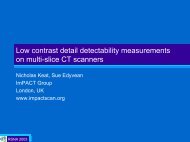Techniques and technology for dose reduction in CT - ImPACT CT ...
Techniques and technology for dose reduction in CT - ImPACT CT ...
Techniques and technology for dose reduction in CT - ImPACT CT ...
Create successful ePaper yourself
Turn your PDF publications into a flip-book with our unique Google optimized e-Paper software.
<strong>Techniques</strong> <strong>and</strong> <strong>technology</strong> <strong>for</strong> <strong>dose</strong> <strong>reduction</strong> <strong>in</strong> <strong>CT</strong><br />
Nick Keat, ImPA<strong>CT</strong><br />
St George’s HospitalI<br />
London<br />
Dose Reduction <strong>in</strong> Diagnostic Radiology
About ImPA<strong>CT</strong><br />
• Based at St George’s<br />
Hospital, Toot<strong>in</strong>g, London<br />
• Employed by Medic<strong>in</strong>es <strong>and</strong><br />
Healthcare products<br />
Regulatory Agency (MHRA*)<br />
to evaluate <strong>CT</strong> scanners <strong>for</strong><br />
the NHS<br />
*<strong>for</strong>merly MDA<br />
Dose Reduction <strong>in</strong> Diagnostic Radiology
Introduction – techniques <strong>and</strong> technologies<br />
• Is there a problem?<br />
• Where do opportunities <strong>for</strong> <strong>dose</strong> <strong>reduction</strong> exist?<br />
• What can we do now? <strong>Techniques</strong><br />
• What is <strong>in</strong> development? Technologies<br />
Dose Reduction <strong>in</strong> Diagnostic Radiology
Is there a problem?<br />
Jan 22, 2001<br />
<strong>CT</strong> scans <strong>in</strong> children l<strong>in</strong>ked to cancer<br />
By Steve Sternberg, USA TODAY<br />
Each year, about 1.6 million children <strong>in</strong> the USA get <strong>CT</strong> scans to the head <strong>and</strong> abdomen<br />
— <strong>and</strong> about 1,500 of those will die later <strong>in</strong> life of radiation-<strong>in</strong>duced cancer, accord<strong>in</strong>g to<br />
research out today.<br />
What's more, <strong>CT</strong> or computed tomography scans given to kids are typically calibrated<br />
<strong>for</strong> adults, so children absorb two to six times the radiation needed to produce clear<br />
images , a second study shows. These <strong>dose</strong>s are "way bigger than the sorts of <strong>dose</strong>s that<br />
people at Three Mile Isl<strong>and</strong> were gett<strong>in</strong>g," David Brenner of Columbia University says.<br />
"Most people got a tenth or a hundredth of the <strong>dose</strong> of a <strong>CT</strong>."<br />
Dose Reduction <strong>in</strong> Diagnostic Radiology<br />
Brenner DJ et al Estimated risks of radiation-<strong>in</strong>duced<br />
fatal cancer from pediatric <strong>CT</strong>. AJR 176:289-296 (2001)
Is there a problem?<br />
• <strong>CT</strong> is <strong>in</strong>herently a high <strong>dose</strong> exam<strong>in</strong>ation, <strong>and</strong> <strong>dose</strong> is ris<strong>in</strong>g<br />
• Numbers are relatively low : ~4% of exam<strong>in</strong>ations 1<br />
• BUT total contribution to <strong>dose</strong>s from medical exams is high:<br />
~40% of total 1<br />
1989 1999<br />
2%<br />
20%<br />
4%<br />
40%<br />
Exams<br />
Dose<br />
Exams<br />
Dose<br />
Dose Reduction <strong>in</strong> Diagnostic Radiology<br />
1<br />
NRPB estimates
Is there a problem?<br />
• The amount of <strong>in</strong><strong>for</strong>mation <strong>in</strong> a <strong>CT</strong> exam is far greater than<br />
an equivalent plane x-ray<br />
• Huge amount of diagnostic <strong>in</strong><strong>for</strong>mation available<br />
• Can’t get ‘someth<strong>in</strong>g <strong>for</strong> noth<strong>in</strong>g’<br />
<strong>CT</strong> head ~ 2 mSv<br />
<strong>CT</strong> chest ~ 8 mSv<br />
<strong>CT</strong> abdomen ~ 10 mSv<br />
<strong>CT</strong> pelvis ~ 10 mSv<br />
X-ray skull ~ 0.03 mSv<br />
X-ray chest ~ 0.02 mSv<br />
X-ray abdomen ~ 0.7 mSv<br />
X-ray pelvis ~ 0.7 mSv<br />
• <strong>CT</strong> uses digital detectors that do not over-range like film<br />
• An ‘over-exposure’ is rewarded with better image quality<br />
• Until recently, no <strong>for</strong>m of AEC was available <strong>for</strong> <strong>CT</strong><br />
• More about that later<br />
Dose Reduction <strong>in</strong> Diagnostic Radiology
Th<strong>in</strong>gs to bear <strong>in</strong> m<strong>in</strong>d<br />
• Diagnostic image quality is overrid<strong>in</strong>g concern<br />
• No po<strong>in</strong>t reduc<strong>in</strong>g <strong>dose</strong> until image is useless – 100% wasted<br />
<strong>dose</strong>!<br />
• Some <strong>dose</strong> sav<strong>in</strong>gs can be made without affect<strong>in</strong>g image<br />
quality at all<br />
• The rema<strong>in</strong>der comes down to <strong>dose</strong> <strong>and</strong> image quality<br />
optimisation<br />
Dose Reduction <strong>in</strong> Diagnostic Radiology
Where do opportunities exist?<br />
• Elim<strong>in</strong>ate unnecessary exams<br />
• Other diagnostic tests may be available<br />
• Ensure exams are targeted to necessary organs<br />
• Chestabdomenpelvis is not a s<strong>in</strong>gle word!<br />
Dose Reduction <strong>in</strong> Diagnostic Radiology
Where do opportunities exist?<br />
• Optimise scan protocols<br />
• Is a pre-contrast scan necessary?<br />
• Are multiple phases all necessary?<br />
• kV / collimation / pitch / mAs<br />
• Tailored exposure parameters <strong>for</strong> the <strong>in</strong>dividual<br />
• Use gantry tilt<br />
• Shield<strong>in</strong>g of sensitive organs<br />
• Comparison with reference <strong>dose</strong>s<br />
Dose Reduction <strong>in</strong> Diagnostic Radiology
<strong>Techniques</strong> : Scan protocol optimisation<br />
• Process of ensur<strong>in</strong>g that the scan <strong>and</strong> exposure parameters<br />
provide the best balance <strong>in</strong> terms of<br />
• Image quality<br />
• Radiation <strong>dose</strong><br />
• Other factors, e.g. total scan time<br />
• Adjustable parameters<br />
• kV<br />
• Collimation / slice thickness<br />
• Pitch / feed per rotation<br />
• mAs<br />
Dose Reduction <strong>in</strong> Diagnostic Radiology
Scan protocol optimisation : kV<br />
• Generally st<strong>and</strong>ardised at around 120 kV<br />
• Lower kV : 80 / 100 can be used<br />
• Higher <strong>dose</strong> <strong>for</strong> same image noise<br />
• Better contrast than at 120kV<br />
• Iod<strong>in</strong>e – soft tissue contrast is better, so may be optimal <strong>for</strong> some<br />
angiographic head exams<br />
• Can be used <strong>in</strong> paediatric protocols to reduce beam <strong>in</strong>tensity<br />
• Higher kV : 135 / 140 sometimes used<br />
• Marg<strong>in</strong>ally lower <strong>dose</strong> <strong>for</strong> same image noise<br />
• Contrast is slightly poorer<br />
• Penetration is greater<br />
• Can be used <strong>for</strong> obese patients or dense body sections<br />
Dose Reduction <strong>in</strong> Diagnostic Radiology
Scan protocol optimisation : collimation<br />
• In multi slice <strong>CT</strong>, narrow collimations result <strong>in</strong> higher <strong>dose</strong><br />
due to ‘overbeam<strong>in</strong>g’ <strong>in</strong> z-axis<br />
• Avoid imag<strong>in</strong>g us<strong>in</strong>g the penumbra of the beam<br />
• Effect is less significant at wider collimations, <strong>and</strong><br />
<strong>for</strong> 16 slice than 4 slice at same image width<br />
• e.g. GE LightSpeed, LightSpeed Ultra <strong>and</strong><br />
LightSpeed 16<br />
Collimation<br />
4 x 1.25 (5 mm)<br />
8 x 1.25 (10 mm)<br />
16 x 1.25 (20 mm)<br />
Z-axis geometric<br />
efficiency (%)<br />
67<br />
83<br />
97<br />
z-axis<br />
Dose Reduction <strong>in</strong> Diagnostic Radiology
Scan protocol optimisation : slice width<br />
• Reconstructed slice width doesn’t directly affect <strong>dose</strong><br />
• Available slice widths def<strong>in</strong>ed by collimation<br />
• Can’t reconstruct a 1 mm slice from 2 mm data<br />
• Th<strong>in</strong>ner slices are more noisy<br />
• Slice width affects contrast : partial volume effect<br />
• Optimum when slice width = z-axis length of object<br />
Noise ∝ 1/( slice)<br />
More noisy<br />
Dose Reduction <strong>in</strong> Diagnostic Radiology<br />
Less contrast<br />
Contrast ∝ 1/(slice)*<br />
* Due to partial volume effect
Scan protocol optimisation : helical pitch<br />
• Higher pitch gives proportionally lower patient <strong>dose</strong><br />
• At the expense of slice width <strong>and</strong> contrast with s<strong>in</strong>gle slice<br />
• At the expense of noise or/<strong>and</strong> slice width <strong>in</strong> multi-slice<br />
• Some manufacturers <strong>in</strong>crease mA to compensate <strong>for</strong> pitch<br />
‘effective mAs’ or ‘mAs per slice’<br />
• Higher pitch generally gives more helical artefacts<br />
• But also leads to faster scan times<br />
• Compromise is necessary<br />
• Priorities depend on application<br />
Dose Reduction <strong>in</strong> Diagnostic Radiology
Scan protocol optimisation : mAs<br />
• Dose is proportional to mAs<br />
• Image noise decreases with <strong>in</strong>creas<strong>in</strong>g mAs<br />
• noise ∝ 1/(<br />
mAs)<br />
• Optimal mAs is very difficult to def<strong>in</strong>e<br />
• Always have to err on the side of over-exposure to avoid<br />
repeat exams. But by how much?<br />
• Variety of techniques can be used: addition of simulated noise,<br />
studies with cadavers<br />
Dose Reduction <strong>in</strong> Diagnostic Radiology
<strong>Techniques</strong> : tailored exposure parameters<br />
• A protocol mAs is generally def<strong>in</strong>ed <strong>for</strong> ‘st<strong>and</strong>ard’ sized<br />
patient<br />
• Need to adjust this <strong>for</strong> larger <strong>and</strong> smaller patients to ensure<br />
consistent image quality<br />
Dose Reduction <strong>in</strong> Diagnostic Radiology
Tailored exposure parameters <strong>for</strong> the <strong>in</strong>dividual<br />
• X-ray <strong>in</strong>tensity halved approx. every 5 cm of patient<br />
• Could double/halve mAs <strong>for</strong> patients 5 cm larger or smaller<br />
than st<strong>and</strong>ard<br />
• mA adjustment usually more conservative than this<br />
• Image quality requirements may be different <strong>for</strong> different sized<br />
patients; generally want lower noise <strong>for</strong> small patients<br />
• Suggested to double/halve mAs <strong>for</strong> patients 10 cm larger or<br />
smaller than st<strong>and</strong>ard*<br />
Dose Reduction <strong>in</strong> Diagnostic Radiology<br />
*Dose optimization <strong>in</strong> <strong>CT</strong>: implementation <strong>and</strong> cl<strong>in</strong>ical<br />
acceptance of size-based technique charts,<br />
CH McCollough, RSNA 2002
Tailor<strong>in</strong>g exposure parameters to the <strong>in</strong>dividual<br />
• e.g. <strong>for</strong> abdomen scans, measure lateral patient width from<br />
AP scout at liver. St<strong>and</strong>ard mAs is set <strong>for</strong> 40cm*<br />
Patient Width (cm)<br />
Relative mAs<br />
> 21 - 26<br />
> 26 - 31<br />
> 31 - 36<br />
> 36 - 41<br />
> 41 - 46<br />
> 46 - 51<br />
0.4<br />
0.5<br />
0.7<br />
1.0<br />
1.4<br />
2.0<br />
Dose Reduction <strong>in</strong> Diagnostic Radiology<br />
*Dose optimization <strong>in</strong> <strong>CT</strong>: implementation <strong>and</strong> cl<strong>in</strong>ical<br />
acceptance of size-based technique charts,<br />
CH McCollough, RSNA 2002
Weight / age based paediatric protocols<br />
• Pre-programmed paediatric protocols available on most<br />
systems<br />
• Siemens & Philips<br />
• age-based <strong>for</strong> heads<br />
• weight-based <strong>for</strong> bodies<br />
• GE colour-coded system<br />
• assigns scan parameters accord<strong>in</strong>g to weight-zone colour<br />
e.g. 6 - 7.4kg, 7.5 - 8.4kg, 8.5 - 11.4kg, 11.5 - 14.4kg …<br />
• ties <strong>in</strong> with hospital-wide Broselow-Luten, ‘Ra<strong>in</strong>bow’ System<br />
which covers drug <strong>dose</strong>s, needle sizes etc<br />
Dose Reduction <strong>in</strong> Diagnostic Radiology
<strong>Techniques</strong> : Gantry tilt<br />
• Has the potential to reduce <strong>dose</strong> to sensitive organs, e.g.<br />
the eye lenses <strong>in</strong> head scann<strong>in</strong>g<br />
• Dose levels are too low <strong>for</strong> cataract <strong>for</strong>mation<br />
~ 50-100 mGy to lenses from head <strong>CT</strong><br />
cataract threshold ~ 500 (acute) – 1000’s mGy<br />
Dose Reduction <strong>in</strong> Diagnostic Radiology
<strong>Techniques</strong> : shield<strong>in</strong>g sensitive organs<br />
• Attenuat<strong>in</strong>g bismuth based shields are available <strong>for</strong><br />
shield<strong>in</strong>g of superficial sensitive organs<br />
• Can reduce the <strong>dose</strong> to the lens of the eyes, thyroid or breast<br />
• Re-usable, but sterilisation can be an issue<br />
Dose Reduction <strong>in</strong> Diagnostic Radiology<br />
Radioprotection to the Eye Dur<strong>in</strong>g <strong>CT</strong> Scann<strong>in</strong>g,<br />
Hopper et al, AJNR 22:1194-1198 (6 2001)
<strong>Techniques</strong> : extra rotations <strong>in</strong> helical scann<strong>in</strong>g<br />
• To reconstruct the first <strong>and</strong> last image <strong>in</strong> a helical series,<br />
data is gathered from outside the nom<strong>in</strong>al scan volume<br />
• Irradiation outside the scan volume can depend on various<br />
factors (collimation, slice width, pitch, recon. technique)<br />
• More significant <strong>for</strong> short multi-slice scans, with small no. of<br />
rotations<br />
• Worth consider<strong>in</strong>g different collimation or axial scann<strong>in</strong>g <strong>in</strong><br />
these situations<br />
Dose Reduction <strong>in</strong> Diagnostic Radiology
<strong>Techniques</strong> : comparison with reference <strong>dose</strong>s<br />
• Reference <strong>dose</strong>s are available, giv<strong>in</strong>g <strong>CT</strong>DI w <strong>and</strong> DLP <strong>for</strong> a<br />
range of common exam<strong>in</strong>ations<br />
• See http://www.drs.dk/guidel<strong>in</strong>es/ct/quality/<strong>in</strong>dex.htm<br />
• Data based ma<strong>in</strong>ly on NRPB survey data from 1990<br />
• NRPB, <strong>in</strong> association with the <strong>CT</strong> Users Group <strong>and</strong> ImPA<strong>CT</strong><br />
are updat<strong>in</strong>g this data. Survey data has been returned, <strong>and</strong><br />
is be<strong>in</strong>g analysed<br />
• <strong>CT</strong>DI w <strong>and</strong> DLP values<br />
are displayed on modern<br />
scanner consoles<br />
<strong>for</strong> comparison<br />
<strong>CT</strong>DIw 2.28mGy<br />
Dose Reduction <strong>in</strong> Diagnostic Radiology
Technology : Multi-slice scanners <strong>and</strong> <strong>dose</strong><br />
• Four slice scanners first <strong>in</strong>troduced <strong>in</strong> 1998 by four major<br />
manufacturers<br />
• 16 slice systems<br />
now widely available<br />
• Possible to buy a<br />
1, 2, 4, 6, 8,10 or 16<br />
slice system<br />
Dose Reduction <strong>in</strong> Diagnostic Radiology
Multi-slice scanners <strong>and</strong> <strong>dose</strong><br />
• Have already covered collimation issues<br />
• Apart from that, there are no significant differences <strong>in</strong> basic<br />
dosimetry between s<strong>in</strong>gle <strong>and</strong> multi-slice<br />
• Ma<strong>in</strong> issues relate to how the scanners are used<br />
• Multi-slice scanners are more flexible<br />
• Can use their advantages to give faster scann<strong>in</strong>g, better z-axis<br />
resolution or greater coverage<br />
Dose Reduction <strong>in</strong> Diagnostic Radiology
Multi-slice scanners <strong>and</strong> <strong>dose</strong><br />
• Greater flexibility af<strong>for</strong>ded by MS <strong>CT</strong> can tempt users to<br />
• scan larger volumes<br />
• scan more phases <strong>in</strong> multi-phase studies<br />
• <strong>in</strong>crease mAs to keep noise down <strong>in</strong> th<strong>in</strong> slices<br />
Dose Reduction <strong>in</strong> Diagnostic Radiology
What is be<strong>in</strong>g developed : <strong>technology</strong><br />
• Multi-slice is the most significant development s<strong>in</strong>ce helical<br />
• Ma<strong>in</strong> <strong>technology</strong> be<strong>in</strong>g developed <strong>in</strong> <strong>CT</strong> affect<strong>in</strong>g patient<br />
<strong>dose</strong> is automated tube current adjustment<br />
Dose Reduction <strong>in</strong> Diagnostic Radiology
How the systems work<br />
• In order to set mA, systems need knowledge of patient<br />
attenuation. This comes from:<br />
• SPR (scout, pilot, topogram or scanogram) views <strong>and</strong>/or<br />
• Knowledge of the attenuation from the previous rotation<br />
• To use the system, the operator needs to be able to set the<br />
desired exposure level by use of:<br />
• A ‘st<strong>and</strong>ard’ mAs<br />
• A reference image of the desired image quality<br />
• A desired image noise level<br />
Dose Reduction <strong>in</strong> Diagnostic Radiology
Technology : automatic mA adjustment<br />
• Can work on 3 levels, adjust<strong>in</strong>g <strong>for</strong> attenuation differences<br />
• From patient to patient<br />
• Along patient length – z-axis<br />
• In AP <strong>and</strong> lateral directions – rotational<br />
attenuation<br />
low attenuation<br />
high attenuation<br />
• <strong>CT</strong> has f<strong>in</strong>ally caught up with planar x-ray <strong>and</strong> has the<br />
equivalent of an AEC<br />
• In <strong>CT</strong>, tube current, not exposure time is be<strong>in</strong>g controlled<br />
Dose Reduction <strong>in</strong> Diagnostic Radiology
Automatic mA adjustment<br />
• Tube current is adjusted dur<strong>in</strong>g scann<strong>in</strong>g to compensate <strong>for</strong><br />
attenuation differences – <strong>dose</strong> applied to patient only where<br />
needed, avoid<strong>in</strong>g <strong>dose</strong> where it isn’t<br />
mA<br />
position<br />
Dose Reduction <strong>in</strong> Diagnostic Radiology
Advantages of automatic mA control<br />
• More constant signal to detectors<br />
• Image quality is ma<strong>in</strong>ta<strong>in</strong>ed at constant level<br />
• Tube heat capacity conserved<br />
• Reduction <strong>in</strong> ‘photon starvation’ streak artefact<br />
• Dose optimisation<br />
Dose Reduction <strong>in</strong> Diagnostic Radiology
What’s available now<br />
• All systems still be<strong>in</strong>g developed<br />
• The follow<strong>in</strong>g shows current availability – all manufacturers<br />
say more will be available <strong>in</strong> future versions<br />
Patient size mA<br />
adjustment<br />
Z-axis<br />
adjustment<br />
Rotational<br />
adjustment<br />
GE<br />
Philips<br />
Siemens<br />
DoseRight ACS<br />
Auto mA<br />
DoseRight DOM<br />
CareDose<br />
Toshiba<br />
Real EC<br />
Dose Reduction <strong>in</strong> Diagnostic Radiology
Results from automatic mA systems<br />
• ImPA<strong>CT</strong> have tested auto mA systems on 16 slice scanners<br />
from all manufacturers, us<strong>in</strong>g an elliptical cone phantom<br />
Noise (%)<br />
28<br />
24<br />
20<br />
16<br />
12<br />
automA off<br />
Noise Index 16<br />
Noise Index 12<br />
Noise Index 8<br />
Noise Index 4<br />
8<br />
4<br />
0<br />
-150 -100 -50 0 50 100 150<br />
Z-position (mm)<br />
Dose Reduction <strong>in</strong> Diagnostic Radiology<br />
Results from GE LightSpeed 16
Summary<br />
• Patient <strong>dose</strong>s from <strong>CT</strong> are high despite the relatively low<br />
number of exam<strong>in</strong>ations<br />
• The cost <strong>in</strong> <strong>dose</strong> is rewarded with extra diagnostic<br />
<strong>in</strong><strong>for</strong>mation<br />
• <strong>Techniques</strong> with exist<strong>in</strong>g equipment to reduce <strong>dose</strong> are the<br />
usual ones : justification <strong>and</strong> optimisation<br />
• The <strong>technology</strong> is advanc<strong>in</strong>g with systems that have<br />
automatic tube current control<br />
• Improves the <strong>dose</strong> – image quality trade off<br />
• Aids optimisation of technique<br />
Slides from this talk will be available at<br />
www.impactscan.org next week<br />
Dose Reduction <strong>in</strong> Diagnostic Radiology














